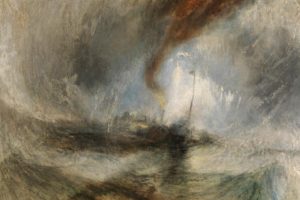No one has ever been able to fit the painter J.M.W. Turner into a niche. He sprawls all over art history, just as his lengthy name, Joseph Mallard William Turner, seems to take up half a sentence. The popular view is that this British landscape painter, who lived from 1775 to 1851, was “ahead of his time,” and that he somehow foresaw or was a precursor to French Impressionism.

“Snow Storm – Ship off a Harbor’s Mouth.”
That, in fact, was the basis of the last big Turner exhibit in this country, held in 1966 at the Museum of Modern Art. Half the selected paintings were unfinished ones, making Turner appear to be more of an abstractionist than he really was. There’s vanity in editing Turner’s career so as to claim him as a modern painter, as if the art values of the 20th century were so patently superior to those of the past.
Better to approach Turner as a painter of his own time – as a romantic visionary in love with the effects of air and light and water. As he put it himself: “Atmosphere is my style.” That is the Turner that you will find at the Metropolitan Museum’s outstanding summer exhibit, titled, simply, “J.M.W. Turner.”
Turner made his reputation as a painter of the sea. His “Shipwreck” from 1805 depicts the survivors struggling to stay afloat in their lifeboats. In that sense, it’s like Theodore Gericault’s “Raft of the Medusa,” painted some 15 years later. The difference is that Gericault used the subject of a shipwreck to stage a human drama, while Turner, you sense, used human drama as an excuse to depict the roiling sea.
Nature’s shape-shifting phenomena were what fascinated Turner. Even when he went to the mountains, he favored canyons where tumbling cataracts tossed up clouds of mist that rendered rocks insubstantial. The critics didn’t get it. In the powerful canvas, “Fall of the Rhine, Schaffhausen,” Turner scraped in the thunderous rush of water with a palette knife. A contemporary writer complained of its “negligence and coarseness.”

“The Burning of the Houses of Lords and Commons,” painted in 1834.
In many such paintings, including the one of General Hannibal being menaced by the yawning mouth of an Alpine snowstorm, Turner looks more like a father of the Hudson River School. Like those painters, Turner was drawn to “the sublime,” terrifying and awe-inspiring spectacles of nature that were spiritually transcendent. I’d always thought that this was a homegrown idea, but Turner, it seems, was there well before Thomas Cole, Frederick Church and Albert Bierstadt.
You expect great romantic artists to look dashing, but Turner was described by one contemporary as “a mean looking little man.” Eugene Delacroix, who did look the role, thought Turned looked more like a farmer than a painter. He had a journalist’s love of deadline: he’d submit half-finished paintings to the Royal Academy exhibits, then, under a rule that allowed for touch ups prior to its opening, he would go in and work feverishly to finish the painting.

“The Dogano, San Giorgio, Citella, from the Steps of the Europa.”
Like the impressionists, Turner gave light a primacy in his paintings. And he was there first. He died in 1851, 20 years before the term “impressionism” was even conceived. But no one has ever shown much of a connection. And Turner could never have tolerated impressionism’s rigid optical system of dots and dabs. His painting effects were so ethereal that John Constable described him as painting with “steam.” Where Turner looks really modern is in his studies and watercolors, especially the series for “The Burning of the Houses of Parliament.” These seem to vault right over impressionism into the abstractions of John Marin and the Italian futurists.
The fun in looking at Turner is not in trying to make historical connections where they don’t exist, but in seeing how a painter who worked more than 150 years ago can touch so many chords that we think of as exclusively modern.

